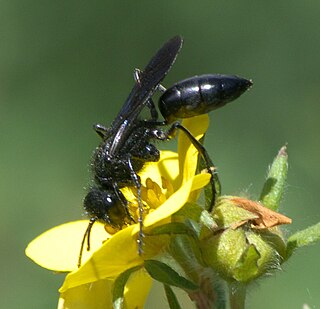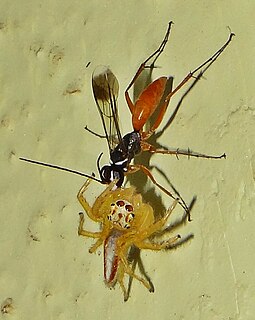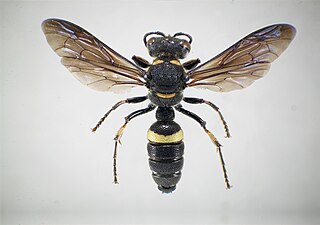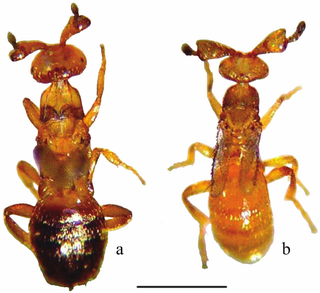
The black and yellow mud dauber, Sceliphron caementarium, is a species of sphecid wasp. There are some 30 other species of Sceliphron that occur throughout the world, though in appearance and habits they are quite similar to S. caementarium.

The Apocrita are a suborder of insects in the order Hymenoptera. It includes wasps, bees, and ants, and consists of many families. It contains the most advanced hymenopterans and is distinguished from Symphyta by the narrow "waist" (petiole) formed between the first two segments of the actual abdomen; the first abdominal segment is fused to the thorax, and is called the propodeum. Therefore, it is general practice, when discussing the body of an apocritan in a technical sense, to refer to the mesosoma and metasoma rather than the "thorax" and "abdomen", respectively. The evolution of a constricted waist was an important adaption for the parasitoid lifestyle of the ancestral apocritan, allowing more maneuverability of the female's ovipositor. The ovipositor either extends freely or is retracted, and may be developed into a stinger for both defense and paralyzing prey. Larvae are legless and blind, and either feed inside a host or in a nest cell provisioned by their mothers.

The Sphecidae are a cosmopolitan family of wasps of the suborder Apocrita that includes sand wasps, mud daubers, and other thread-waisted wasps.

Mud dauber is a name commonly applied to a number of wasps from either the family Sphecidae or Crabronidae that build their nests from mud; this excludes members of the family Vespidae, which are instead referred to as "potter wasps". Mud daubers belong to different families and are variable in appearance. Most are long, slender wasps about 1 inch (25 mm) in length. The name refers to the nests that are made by the female wasps, which consist of mud molded into place by the wasp's mandibles. Mud daubers are not normally aggressive, but can become belligerent when threatened. Stings are uncommon.

Sceliphron is a genus of Hymenoptera of the Sphecidae family of wasps, commonly referred to as mud daubers. They are solitary and build nests made of mud. Nests are frequently constructed in shaded niches, often just inside of windows or vent openings, and it may take a female only a day to construct a cell requiring dozens of trips carrying mud. Females will add new cells one by one to the nest after each cell is provisioned. They provision these nests with spiders, such as crab spiders, orb-weaver spiders and jumping spiders in particular, as food for the developing larvae. Each mud cell contains one egg and is provided with several prey items. Females of some species lay a modest average of 15 eggs over their whole lifespan. Various parasites attack these nests, including several species of cuckoo wasps, primarily by sneaking into the nest while the resident mud dauber is out foraging.

The organ pipe mud dauber is a predatory wasp in the family Crabronidae. They are fairly large wasps, ranging from 3.9–5.1 cm, and have been recorded to fly from May to September. Female and male are similar in colour, a shiny black with pale yellow to white hind hindtarsomere. The organ pipe mud dauber feeds mainly on three genera of spider: Neoscona, Araneus, and Eustala. Melittobia, a parasitoid wasp, is a common ectoparasite of T. politum prepupae. Other sources of parasitism include the Bombyliid fly Anthrax, Chrysidid wasps, and various species of scavenger flies (Miltogramminae). The tufted titmouse is a known predator of T. politum, and may feed on them more commonly than previously thought as the holes made by the titmouse are similar in shape and size to those made by T. politum leaving the nest after pupation.

Potter wasps, the Eumeninae, are a cosmopolitan wasp group presently treated as a subfamily of Vespidae, but sometimes recognized in the past as a separate family, Eumenidae.

Gasteracantha fornicata is a species of spiny orb-weavers found in Queensland Australia. It is similar in shape to Austracantha minax which was originally described as Gasteracantha minax. It was described by Johan Christian Fabricius in 1775, the first Australian species of spider to be named and classified.

Gasteracantha cancriformis is a species of orb-weaver spider. It is widely distributed in the New World.

The blue mud dauber or blue mud wasp is a metallic blue species of mud dauber wasp first described by Henri Louis Frédéric de Saussure in 1867. It is not normally aggressive towards humans. It is similar in shape and colour to the steel-blue cricket hunter. Like other types of wasps, males do not have an ovipositor, and therefore cannot sting. It is ranged from northern Mexico to southern Canada, including most of the United States. It has also been introduced to regions including Hawaii, Bermuda and Croatia

The Stenogastrinae are a subfamily of social wasps included in the family Vespidae. They are sometimes called hover wasps owing to the particular hovering flight of some species. Their morphology and biology present interesting peculiarities.

Mass provisioning is a form of parental investment in which an adult insect, most commonly a hymenopteran such as a bee or wasp, stocks all the food for each of her offspring in a small chamber before she lays the egg. This behavior is common in both solitary and eusocial bees, though essentially absent in eusocial wasps.

A wasp is any insect of the narrow-waisted suborder Apocrita of the order Hymenoptera which is neither a bee nor an ant; this excludes the broad-waisted sawflies (Symphyta), which look somewhat like wasps but are in a separate suborder. The wasps do not constitute a clade, a complete natural group with a single ancestor, as their common ancestor is shared by bees and ants. Many wasps, those in the clade Aculeata, can sting their insect prey.

Cerceris fumipennis, the only species of buprestid-hunting Crabronidae occurring in eastern North America, is found throughout the continental United States east of the Rockies: from Texas and Florida north to Maine, Wyoming, and into Canada. The wasps most often nest in open areas of hard-packed sandy soil surrounded by woody habitat suitable for their buprestid beetle prey.

Sceliphron spirifex is a species of sphecid wasp. It has a medium-sized body, which is dull black with a long, yellow petiole (waist). The legs are black with yellow bands, the antennae are black and the wings are clear.

Anoplius viaticus, commonly known as the black-banded spider wasp, is a species of spider wasp. These wasps are known as spider wasps because the females capture spiders to provide their offspring with food. The paralysed spider is cached in a burrow, the wasp lays an egg on it, and when this hatches, the developing wasp larva consumes the spider. This species is found in sandy heathland across most of Europe.

Auplopus albifrons is a spider wasp of the family Pompilidae.

Pison spinolae, commonly known as mason wasp, is a solitary wasp of the family Crabronidae, found throughout New Zealand.

Melittobia australica is a species of chalcid wasp from the family Eulophidae which is a gregarious ecto-parasitoid of acuealate Hymenoptera.
Sceliphron asiaticum is a species of thread-waisted wasp in the family Sphecidae. It is native to the Neotropics, South America and the Caribbean region.

















